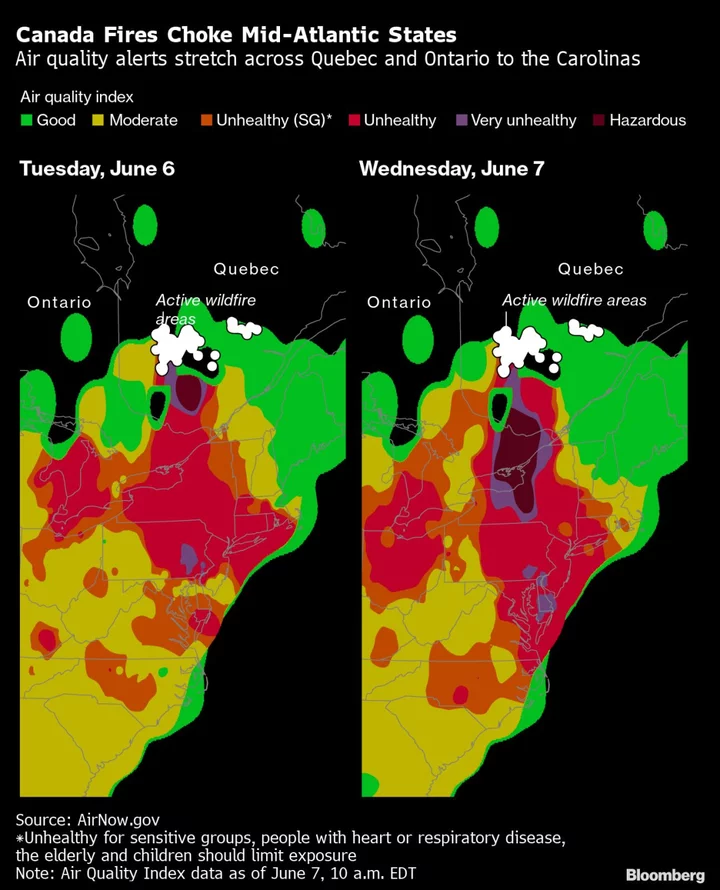
Children evacuated from orphanage where dozens died in Sudan's capital
CAIRO About 300 children have been evacuated from an orphanage in Sudan's capital Khartoum where dozens of orphans
2023-06-08 20:47

Atmosic’s Extremely Low-Power SoC Approved for Google Android TV Remote Controls
CAMPBELL, Calif.--(BUSINESS WIRE)--Jun 8, 2023--
2023-06-08 20:22

The Aga Khan Museum brings the Canada Day long weekend to life with Rhythms of Canada, an exhilarating four-day summer festival
TORONTO--(BUSINESS WIRE)--Jun 8, 2023--
2023-06-08 19:23

New Found Intercepts 26 g/t Au Over 9.45m, Extends Iceberg Strike Length to 575m and to a Depth Of 160m
VANCOUVER, British Columbia--(BUSINESS WIRE)--Jun 8, 2023--
2023-06-08 18:58

Scientists invent world's first ‘breathing, sweating, shivering’ robot
Scientists have created the world's first "breathing, sweating, shivering" robot in a major breakthrough. The technologically-advanced "thermal mannequin" known as ANDI has 35 controlled surfaces that allow the robot to produce sweat through 'pores'. Designed by US firm Thermetrics, there are just 10 ANDIs in the world. It was designed to gauge a better understanding of the health impacts of extreme temperatures on the body. "ANDI sweats, he generates heat, shivers, walks and breathes," explained Konrad Rykaczewski, principal investigator for the ASU research project. Rykaczewski continued: "There’s a lot of great work out there for extreme heat, but there’s also a lot missing. "We’re trying to develop a very good understanding of how heat impacts the human body so we can quantitatively design things to address it." Sign up for our free Indy100 weekly newsletter Some ANDIs are already being used by sports clothing companies to test garments. Meanwhile, ASU's version is the first that can be used outdoors. Jenni Vanos, associate professor in the School of Sustainability said: "You can’t put humans in dangerous extreme heat situations and test what would happen. "But there are situations we know of in the Valley where people are dying of heat and we still don't fully understand what happened. ANDI can help us figure that out." Later this year, ANDI will be paired with ASU's biometeorological heat robot to delve deeper into human sweating mechanisms. Ankit Joshi, an ASU research scientist leading the modelling and operating of ANDI, said: "We can move different BMI models, different age characteristics and different medical conditions (into ANDI),” "A diabetes patient has different thermal regulation from a healthy person. So we can account for all this modification with our customized models." Have your say in our news democracy. Click the upvote icon at the top of the page to help raise this article through the indy100 rankings.
2023-06-08 18:55

The brightest explosion ever seen in the universe has finally been explained
It’s the brightest explosion ever seen in the universe, but until now it’s been a mystery that couldn't be explained. Telescopes observed an enormous blast in October which was regarded as the biggest of all time. It was identified as a gamma-ray burst, named GRB 221009A, which came as a result of a massive star collapsing into a black hole. At the time it was a mystery as to why the explosion shone so brightly. Now, further research published in the journal Science Advances has uncovered the reason it was so bright is due to the fact it was facing directly at us and also pulled stellar material along with it. Sign up to our free Indy100 weekly newsletter Hendrik Van Earthen from the University of Bath said: “The slow fade of the afterglow is not characteristic of a narrow jet of gas, and knowing this made us suspect there was an additional reason for the intensity of the explosion, and our mathematical models have borne this out. “Our work clearly shows that the GRB had a unique structure, with observations gradually revealing a narrow jet embedded within a wider gas outflow where an isolated jet would normally be expected.” The research into GRB 221009A has the potential to further the study of huge gamma-ray bursts, which can produce as much energy as the Sun will in its entire lifetime in the space of just a few seconds. “GRB 221009A represents a massive step forward in our understanding of gamma-ray bursts, and demonstrates that the most extreme explosions do not obey the standard physics assumed for garden variety gamma-ray bursts,” Brendan O’Connor, GW graduate student and lead study author, said. “GRB 221009A might be the equivalent Rosetta stone of long GRBs, forcing us to revise our standard theories of how relativistic outflows are formed in collapsing massive stars.” Have your say in our news democracy. Click the upvote icon at the top of the page to help raise this article through the indy100 rankings.
2023-06-08 18:24

Canada’s Unstoppable Fires Are Starting Summers of Smoke Across US
This week is just the beginning of what could be a long, smoke-filled summer in North America —
2023-06-08 18:20

Philadelphia Sees Worst Air as Fire Impact Lingers: Smoke Latest
The Philadelphia region faced the worst air quality in the US early Thursday as the impact of Canadian
2023-06-08 18:16

Clean Energy Inks New Fueling Agreements with Customers Looking to Reduce Carbon Emissions with RNG
NEWPORT BEACH, Calif.--(BUSINESS WIRE)--Jun 8, 2023--
2023-06-08 18:15

Man and pet dog both diagnosed with kidney cancer at same time
A father-of-three and his pet Labrador, both of whom were diagnosed with kidney cancer just months apart, are now enjoying what little time they have left together after the project manager’s cancer went into remission while his “best friend” only has a short time left to live. Simon O’Brien, 48, had already been crushed by the news that his eight-year-old golden lab, Bella, had just months to live after she was diagnosed with kidney cancer, when he discovered that he too was suffering from the condition in 2022. Both started experiencing similar symptoms, feeling constantly tired and thirsty, before scans revealed they had potentially lethal lumps on their kidneys, which were later diagnosed as cancer. Convinced his days were numbered, Simon visited the Marie Curie website to plan his own funeral and get his family affairs in order, even writing future letters for his three children, Ivy, 27, Callum, 18, and Niamh, 14, to open on big occasions. Thankfully, this proved to be unnecessary when he found out his cancer was in remission earlier this year after undergoing a seven-hour emergency surgery and having his kidney removed. The surgery is sadly too risky for Bella, who only has a short time to live, and so Simon is now making the most of what precious time they have left. “If you are not an animal person, then you probably don’t get it, but if you are are, then you understand,” said Simon, who lives with his wife Ruth in Aintree, Merseyside, and works as an IT project manager for NTT Data. “She is my best friend and is so much more than a dog to us, she is family. “It was like a bolt out of the blue and having two cancers in the family at the same time has been awful. “You are aware of the burden you put on others, even though they might not show it, you can see their worry and concern.” Alarm bells went off when Bella started losing weight, sleeping more and drinking lots of water in May 2022. “Bella was your typical, cliche Labrador – just a family dog, who is always happy and loves playing with children,” said Simon. “She was usually very prim and proper and groomed herself, but she had stopped and constantly had her tail between her legs, which was unusual, so we knew something was wrong.” The family took Bella to the vet, who referred her to a specialist animal hospital in Chester, where a scan confirmed she had terminal kidney cancer. “The vet said there was nothing they could do and she had months to live, and to enjoy our time left with her and make memories,” said Simon. “We’ll get her on some meds and make the most of the time you’ve got.” A few months later [October 2022], Simon, a keen half marathon runner and member of the Liverpool Running Club, started feeling exhausted after his routine training. “I was struggling to finish a training session with the guys and thought I must have really let myself go during the pandemic,” he said. “But then I found myself getting really tired and thirsty, and losing weight without wanting to.” Oblivious, he visited his GP and was referred to his local hospital for tests in November where a CT scan revealed a mass on his right kidney. He said: “(They) told me over the phone that they had found a mass on my right kidney, that they suspected it was cancer and that there was a chance it had spread to my lymph nodes. “At that point I was feeling pretty rubbish because I had continued to lose weight and was feeling very weak.” Simon and Ruth decided to break the devastating news to their children that same month. “Telling the kids was one of the hardest things, but we decided it was best to all go through it together,” he said. “Of course we played out the best-case scenario to them because they are only young. “Quietly to myself I was thinking, ‘Oh my god, I cant believe this, me and my poor dog. “At least I can get the op.” Fearing the worst, Simon launched into preparing his funeral and wrote a series of letters for future special occasions like his children’s big birthdays and weddings. “I was hoping for the best but planning for the worst,” he said. However, his cancer is now in remission after he underwent a seven-hour emergency operation at Royal Liverpool University Hospital to remove his kidney in December. “We only officially got the news last month,” he said. “Seeing the sense of relief on family and friends’ faces was very emotional – a real good feeling.” Sadly, the same cannot be said for Bella, whose cancer is terminal. Despite this, Bella, who is on £600 worth of medication a month, has lived far longer than was originally expected. “The medication is very expensive but has been amazing, and after a week or so we pretty much had her back,” Simon said. “The one thing we have kept going is taking her to the beach because she loves the waves, and for five or ten minutes she’ll forget everything and be a puppy again.” Simon, who stopped working after his diagnosis, heaped praise on his employer NTT Data, which has continued paying his salary throughout his ordeal. Determined to enjoy his time left with Bella he has since embarked on a Park Run challenge to raise money for Marie Curie, which supports terminally-ill people and their families at the end of life with care, information and support. “Everything on the Marie Curie website was in one place with support on finances, funerals, wills and all the practical information you need when you are in that situation,” he said. “It removed the worry and gave me all the information to protect my family’s future. “I wrote letters for my children and even planned my funeral songs. “It gave me peace of mind whereas my health was out of my control.” Dr Laura Chapman, medical director at the Marie Curie Liverpool Hospice, said: “This is such a sad situation, to have Simon and Bella diagnosed with the same type of cancer at the same time is something I have never heard of in my medical career. “The chances of a dog getting this relatively unusual cancer at the same time as her owner are around a million to one. It’s heartbreaking for the family who are now making cherished memories with Bella.” Matt Williams, associate director of information and support at Marie Curie, said: “I am glad that our website was there at a time when Simon needed it most. People with shock diagnosis often have nowhere to turn and need information fast. “So we have created a one-stop information hub to help people put their affairs in order and plan their funeral and finances when the worst happens.” To find help or support, visit the Marie Curie website at www.mariecurie.org.uk/help/support To find out more about Simon and Bella’s Park Run fundraising challenge, visit www.justgiving.com/page/si1of75. Read More Does sunscreen expire, what does SPF mean and which type is best? ‘Fearful’ Shannen Doherty shares devastating cancer update Cancer patients face worsening treatment delays due to lack of staff, finds report
2023-06-08 16:47

How to keep your pet cool and healthy during a heatwave
Learning how to cope in the heat can be a struggle, with the beaming rays of the sun, the inescapable humidity and the ever-rising temperatures tough to handle for many. With the Met Office forecasting a shift in weather patterns in the UK and a “warm plume” of air with highs of 30C heading our way, just imagine how your pet may be feeling. Domestic animals don’t have the luxury of being able to say when they’re feeling overheated or dehydrated, which is why you need to learn how to keep your pet as safe and healthy as possible during these extreme weather conditions. Whether you’re a dog person or own a reptile, this is how to look after your pet properly as the heatwave runs its course. Dogs Dogs with long fur will likely fare worse than their shorter-haired peers during the summer. However, they are able to cool themselves down by panting and releasing heat through their paws, as animal charity Blue Cross explains. Dogs do this because they’re unable to sweat through their skin in the same way as humans do. If a dog does overheat, they could be at risk of suffering from a serious heatstroke, with the charity explaining that “signs of heatstroke in dogs include collapse, excessive panting and dribbling”. “If you suspect your pet is suffering from the condition, move them to a cool place, preferably with a draught, wet their coat with cool - not freezing - water, and contact your vet immediately,” the charity advises. Furthermore, leaving a dog in a car on a hot day can have devastating consequences, as the temperature within the car can soar to extreme levels at a rapid rate, which is why it’s advised never to leave a dog in a car in hot conditions. To ensure that dogs are comfortable during walks on days with excessive heat, the RSPCA recommends only walking your dog in the morning or evening at the peak of summer, as doing so will help prevent them from burning their paws on the pavement or suffering from heatstroke. You must also make sure that your dog always has access to water. Cats Different types of cats may be more prone to sunburn than others, as pet agency Very Important Pets outlines. “Pale-coloured cats are vulnerable to sunburn; particularly on their ears, noses and sparsely haired areas,” the agency states, adding that, “like in humans, sunburn can sometimes lead to skin cancer.” While many cat owners may let their feline friends roam at will, the agency recommends keeping your cat indoors during the hottest time of the day, from around 11am until 3pm. You can even invest in a suncream designed specifically for pets to provide them with adequate protection from the sun’s rays. Having your cat’s fur trimmed could also be a good course of action in order to make them feel more comfortable in the heat. Furthermore, if you think that your cat may be feeling overheated, you can use a damp towel to cool them down. Just like with any other animal, cats shouldn’t be left in cars during a heatwave. Hamsters If you normally keep your hamster in a glass or plastic crate, you should be aware that the interior may be hotter than the average room temperature. This is important to keep in mind when considering where their crate is placed, as putting it on a window sill where it’s exposed to the sun could put your hamster at risk of overheating. Hamster blog site Hammysworld also suggests placing the crate on a stone or tiled floor during the day if possible in order to help the animals remain cool and comfortable. You could even place a ceramic tile within the cage as a means of lowering the temperature of the interior even more. Another trick that the outlet recommends is to place a frozen bottle of water on the side of the outside of the crate while also regularly refreshing your pet’s water supply. Fish You may think that your fish is safe in their tank of water as those outside battle the intense heat and humidity. However, the temperature of the tank can easily rise if the room temperature is higher than normal. If you have heaters in your fish tank, it would be wise to turn them off, Tropical Fish Site recommends, while it may also be worth reducing the normal temperature of the tank if possible. Another method that you can employ to help keep the water cool is to put bags filled with ice at the bottom of the tank. Birds While birds living in exotic locations around the world may be used to hotter climates, chances are that domesticated birds won’t have the same thresholds for higher temperatures. According to Bird Supplies, birds may be very susceptible to sudden changes in their environment, which is why knowing how to keep them cool during a heatwave is important. “Your average bird has a standard core temperature of around 105F or 40C, and are very susceptible to overheating,” the site states. Some signs to look out for that may indicate that your bird is overheating include if its panting, holding its wings far away from its body or exhibiting anxious behaviour. Many birds naturally enjoy spending time outdoors. However, if this is the case, you should make sure that the outdoor space that your bird frequents is equipped with shaded areas. On top of that, the site states that you should make sure to replace the bathing dish of water at the bottom of your bird’s cage at least once a day, while also ensuring that it has a decent supply of clean water to drink. Reptiles and amphibians Reptiles and amphibians are ectothermic or cold-blooded, which means that their body temperature relies on external sources, as detailed by Encyclopaedia Britannica. With that in mind, if the temperature of your home is higher than normal, then your pet snake or lizard could suffer in the hot conditions. Pet store Just For Pets advises first checking whether the temperature of your home falls within your animal’s ideal range. If the temperature exceeds its ideal range, then you can cool them down by providing them with clean water and keeping a small fan close by. Furthermore, you could utilise a similar technique to the one advised for hamster owners by placing a ceramic tile in its enclosure that it can use to lower its body temperature (that you could cool first in the fridge). Plus, if you place an iced bottle of water nearby, it could help reduce the temperature of the air, thus providing your pet with a more bearable environment. Read More How to tell if you have Covid or heatstroke Why do heatwaves in the UK feel hotter than abroad? How to protect pets from wildfire smoke amid air quality alert Dog owners shocked after vet shares list of ‘toxic’ substances Man faces backlash for wanting to bring six-month -old dog to the gym
2023-06-08 16:26

Man who had terminal cancer was told to ‘breathe into a paper bag’
A man who died of brain cancer was misdiagnosed with anxiety and told to “breathe into a paper bag”. Keith Evans was 21 when he collapsed during a suspected panic attack in February 2010. He later developed painful headaches and was given tools to manage his anxiety. Weeks later during a visit to his GP, he was referred for an MRI scan where he was diagnosed with a glioblastoma, a fast-growing and aggressive brain tumour. Despite being given six months to live, Keith survived five-and-half years. He died aged 27 in October 2015. Keith’s mum, Lorraine, from Bulkington, Warwickshire, said: “We felt like paranoid parents. “Although at the time he was interviewing for a new job, we thought this could have caused some unrest but being told he was having panic attacks seemed odd. “After multiple occasions where we called 999 we were told the same thing and Keith was given ways to manage his anxiety; including breathing into a paper bag.” Throughout his cancer battle, he raised tens of thousands of pounds for charity whilst undergoing radiotherapy and life-long chemotherapy treatment. Lorraine added: “Keith wanted to be one of the 5% of GBM patients who survive more than five years. “He made dramatic changes to his lifestyle and took up cycling as he was no longer allowed to drive. “He made a name for himself within the cycling community. A favourite event which came about inspired by his journey was called Ride on Keith. “He got to take part in the event before coming off his bike due to a seizure in 2015. Soon his mobility deteriorated, and a scan showed the tumour had returned.” This weekend, dozens of cyclists are expected to take part in the final bike ride in memory of the father-of-one from Bulkington who died of brain cancer in October 2015, raising funds for Brain Tumour Research. The final ‘Ride on Keith’ event will take place this Saturday (10 June). Since its inception the event has raised more than £7,500 for Brain Tumour Research. Amongst the riders will be Keith’s widow, Harriet Evans and their son, 10-year-old Joel, who was just one when Keith died. The 25, 55 and five-mile children’s friendly cycle ride will set off from Makins Fishery on Bazzard Road at 8:30am. Lorraine said: “For over a decade, we’ve helped to raise the profile of brain tumours and worked towards driving more funding to find a cure for the disease, with Keith at the helm of the events when he was alive. “He achieved so much in the five-and-half-years he survived including cycling 275 miles from London to Paris and covering the 1,000 mile route from Land’s End to John O’Groats over a ten-day period - all during treatment. “Since his death, the event has been a fantastic way to remember him and this year we hope to create lasting memories whilst raising money for Brain Tumour Research. “Although this is the last event of its kind, we will continue to work with the charity to raise awareness for more research into the disease.” One in three people know someone affected by a brain tumour. They kill more children and adults under the age of 40 than any other cancer, yet just 1% of the national spend on cancer research has been allocated to brain tumours since records began in 2002. Mel Tiley, community development manager at Brain Tumour Research, said: “We’re grateful to Keith’s family for sharing his story. “It’s wonderful to hear of everything Keith achieved after receiving a shocking diagnosis. “His story reminds us that brain tumours are indiscriminate, and they can affect anyone and any age. “If we are to understand the complexity of each diagnosis, we need more funding to research the disease.” Read More ‘Fearful’ Shannen Doherty shares devastating cancer update Cancer patients face worsening treatment delays due to lack of staff, finds report Origins of masturbation traced to primates 40 million years ago ‘Fearful’ Shannen Doherty shares devastating cancer update Fitness fanatic, 26, diagnosed with stage 4 cancer after feeling dizzy Do yoga to cut cancer risk, say scientists
2023-06-08 16:24
